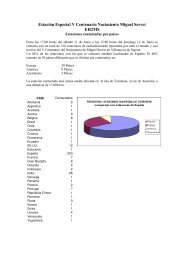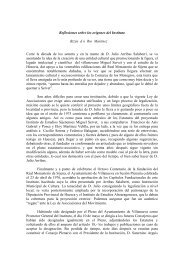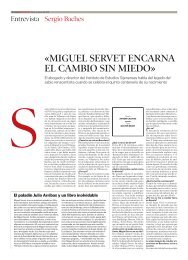New Page
New Page
New Page
Create successful ePaper yourself
Turn your PDF publications into a flip-book with our unique Google optimized e-Paper software.
Rozdzial Starego Testamentu od Nowego is without doubt the most instructive work of Grzegorz<br />
Pawel, one which tells us perhaps most about the ideas of the radical preachers of the ecclesia minor in<br />
Poland active during this period. It will be considered in a different context later; for the time being we<br />
merely want an answer to the question whether and to what extent the intent to synthesize or, to put it<br />
more modestly, to put ideas into one work, as observed in De vera et falsa, is present. The question is<br />
undoubtedly justified by the view, established in the literature on the subject by Konrad Górski's monograph,<br />
that this work is in no way related to Christianismi restitutio.78<br />
If our earlier statements are correct, it can be established right away that at most the direct influence<br />
can be questioned since Górski himself admits that the text of the Polish Antitrinitarian is not<br />
unrelated to the chapter De discrimine legis et euangelii of the famous Transylvanian publication. What<br />
has to be particularly emphasized is that the concluding part of the work contains the +duplex" series<br />
from the appendix of the chapter in question of De falsa et vera. The two texts are not perfectly identical<br />
because Grzegorz Pawel is again rather talkative here, and there are other differences interpretable from<br />
an ideological aspect. These latter can plainly be described by the fact that the Polish version places a<br />
greater emphasis on the importance of the moral superiority of the gospel. Thus in the antitheses of duos<br />
filios and duo regna the Polish text does not fail to stress that the sons of the Old Testament are the<br />
children of wrath and darkness, while those of the <strong>New</strong> Testament belong to meekness and light.<br />
These theses are also important because they cover nearly all the topics discussed in the first part,<br />
providing the theological grounding, of the work consisting of three chapters. After the preface, to be<br />
mentioned later, he commences discussing the two kinds of creation, which is followed by a full<br />
description of the two worlds, the two kinds of life in the spirit of the new interpretation of the Gospel of<br />
John. This also indicates that Grzegorz Pawel does not start with the commencing thought of the chapter<br />
De discrimine but works entirely independently. The same goes for the rest where the dichotomy of the<br />
giving of the soul means the appearance of a completely new element, absent from the assumed sources.<br />
By the way, the modus operandi of Grzegorz Pawel is best characterized by his not being satisfied with<br />
merely stating the differences but also trying to represent them very vividly, while admonishing his<br />
readers on nearly every page. Thus, for instance, he does not merely record that the Levite priests were<br />
carnal and performed outward ceremonies, but often and repeatedly describes these at length. The just<br />
noted Anabaptist element is at the same time also rather forcefully present: it is emphasized with equal<br />
frequency that meekness and toleration should rule in the <strong>New</strong> Testament, that the faithful here bless and<br />
love even their enemies. All this amplifies the autonomous nature of the work. No doubt, it would be useless<br />
to try to find such a close following of the text of Restitutio as in the case of De vera et falsa. At the<br />
same time, I would not claim that it is entirely independent of the Servet's work. For although it is true<br />
that the contrasts demonstrating the differences between the Old and the <strong>New</strong> Testaments (letter--soul,<br />
slave--son, shadow--truth, etc.) do not in themselves refer to Servet, the fact that the concluding part of<br />
the work displays a close connection with the chapter De discrimine, which made maximal use of Restitutio,<br />
is a serious argument against dismissing these contrasts as simply topical.<br />
In the subsequent chapters written with great dynamism the whole system of the Catholic church<br />
is mercilessly criticized, but the Protestant denominations and the Jews also get their share of criticism.<br />
According to the notion elaborated in the preface and repeated ad nauseam, the +present-day Babylon" is<br />
the result of Satan's confusing perfect evangelical knowledge with the old Jewish Testament. On the other<br />
hand, what had happened earlier to the Old Testament has been repeated after Christ: Satan has totally<br />
turned the true learning inside out with pagan inventions and the introduction of new gods like Baal,<br />
Moloch, Dagon, and so on. This latter element may remind us of Servet, but it is important to point out<br />
that the Antichrist does not assume cosmic dimensions, nor are his earlier forms of manifestation<br />
discussed, in the work of the Polish Antitrinitarian, but the more traditional image of the false prophet<br />
rising among the heathen in the days of the apostles is dominant instead. In that respect there is a great<br />
difference between Grzegorz Pawel's infinitely simple, easy to grasp, one might even say simplified,<br />
conception and that of Servet, complicated and elaborated with great refinement. As it is well-known, ac-<br />
28







